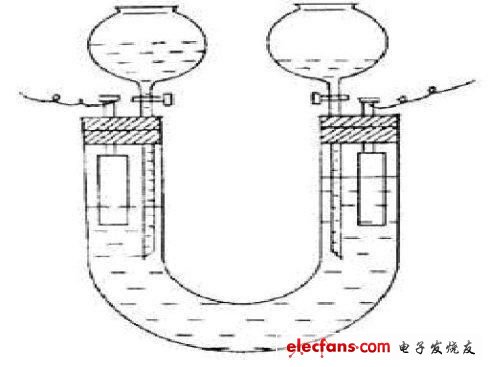Teach you how to make a hydrogen-oxygen fuel cell
Fuel cells are a new class of chemical batteries. Hydrogen, oxygen, methane, etc. can all be used as raw materials. It has the advantages of high energy conversion rate, no pollution, and saving metal resources, and has great application value. However, since such batteries must use special catalysts, which are now difficult to manufacture and expensive, they are not widely available and can only be used in high-tech fields such as satellites and space stations. We used the knowledge of the original battery and electrolytic cell that we have learned, and produced a hydrogen-oxygen fuel cell that can be used for demonstration in the school's scientific and technological activities. Now introduced as follows:
First, the appliance
U-shaped tube, graphite carbon rod, separatory funnel, alcohol burner, low-voltage DC power supply, 30% potassium hydroxide solution (or 30% dilute sulfuric acid), rubber stopper (double hole), wire, etc.
Second, the production principle
A porous carbon rod was used as the positive and negative electrodes of the fuel cell, and a 30% potassium hydroxide solution was used as the electrolyte solution. The negative electrode adsorbs hydrogen and the positive electrode adsorbs oxygen. When the oxyhydrogen fuel cell is operated, hydrogen on the negative electrode emits electrons, an oxidation reaction occurs, and oxygen on the positive electrode receives electrons, and a reduction reaction occurs.
Negative electrode 2H2 + 4OH- - 4e === 4H2O
Positive O2 + 2H2O + 4e === 4OH-
Total reaction 2H2 + O2 === 2H2O
Third, the production process
1. Processing of porous carbon rods
The graphite carbon rod is placed on an alcohol burner to heat and remove the gum therein, and quenched 3 to 4 times to form a porous carbon rod, that is, a porous carbon electrode.
2. The porous carbon electrode, the U-shaped tube, the separatory funnel, and the rubber stopper were assembled as shown in the figure; the U-shaped tube was filled with a potassium hydroxide solution through a separatory funnel, and sealed.
3. Preparation of hydrogen and oxygen
Adjust the voltage of the low-voltage power supply to 6 volts, and connect the positive and negative poles to the two carbon electrodes in the above device; turn on the power, electrolyze the potassium hydroxide solution to produce hydrogen and oxygen, and obtain the hydrogen and The volume ratio of oxygen is 2..1. Remove the power supply, the device shown below becomes a hydrogen-oxygen fuel cell.

We adopt the advanced technology imported from Europe, patented technology, specialized software to optimize the design for Dry Type Transformer. The core is made of cold-rolled grain-oriented silicon steel sheet which cut in step-lap by GEORG Germany TBA core cutting lines and laminated by the method of fifth-order step-by-step stacking technology, enabling the no-load performance of the core to improve greatly. The epoxy resin from American HUNTSMAN is adopted for the windings which casted in the vacuum resin casting machine imported from HEDRICH, Germany. The winding material ensures good permeability, no bubbles occur, which leads to minimum partial discharge. The HV and LV winding mate with each other tightly, which ensures solid strength of structure and capability to withstand short circuit and vibration. Under normal service condition, the service life of dry type transformer is 30 years. No crack will form on the surface of transformer winding due to temperature variation as long as the transformer runs under normal service condition.
Dry Type Transformer
Dry Type Transformer,High Quality Special Transformer,1600Kva Dry-Type Transformer,800Kva Dry-Type Transformer
Hangzhou Qiantang River Electric Group Co., Ltd.(QRE) , https://www.qretransformer.com